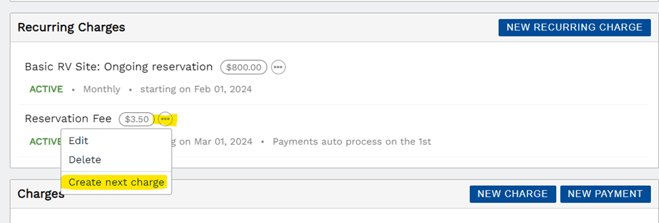There are situations where you may need to create a new recurring charge manually or edit an existing recurring charge. See the steps below on how to create a new recurring charge and how to manage each of the available settings.
Last Updated: October 20, 2025
Link to Feature: https://app.fireflyreservations.com/reservations (or click here then search for the reservation needed)
Quick Links
- Price, Quantity, and Taxes
- Charge Frequency
- "Create First Charge On" Date
- "End Recurring Charge On" Date
- Current Cycle
- Create Days Early
- Email Notification Option
- Automatic Payment Options
Overview
While Firefly automatically creates a recurring charge when a standard reservation is converted to ongoing, it is sometimes necessary to create additional recurring charges for things like reservation fees, utility services, park rental items, or services provided to the guest. These additional recurring charges are created manually.
Recurring charges are created and managed on the Charges tab of a reservation. Under the Summary box and above the Charges section, the Recurring Charges section is always visible. It remains even if no recurring charges are setup and the section is empty.
The Recurring Charges section is specifically for the creation and management of the reservation's recurring charges, while the Charges section includes all charges posted to the reservation.
The step-by-step instructions below walk you through creating a new recurring charge, and each step's detailed information is also helpful when editing an existing recurring charge.
IMPORTANT: Since it may be necessary to continue charges for a guest after a reservation ends, recurring charges can continue after a reservation's departure date. A guest also retains access to a reservation's guest portal for payment access since guest portals never expire.
Recurring charges do not end when a reservation is checked-out. You must ensure the recurring charge's setup or ongoing reservation has an accurate end date. Changing stay dates to enter a departure for an ongoing reservation automatically edits the end date of all recurring charges, to match the end date of the reservation.
Create a new recurring charge.
1. Manually create a new recurring charge.
To manually add a recurring charge, go to a reservation's Charges tab. Find the Recurring Charges section. Select “New Recurring Charge”, highlighted below.
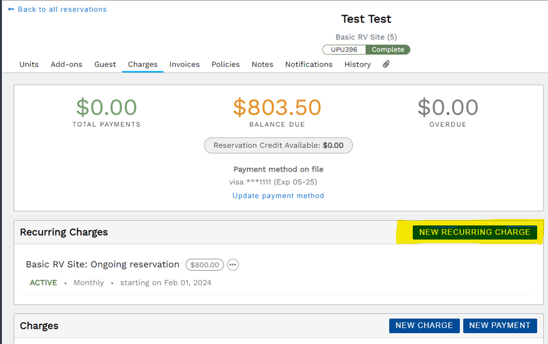
2. Select what the recurring charge is for.
In this example, we are creating a recurring charge for the $3.50 reservation fee, so that is what we will select.
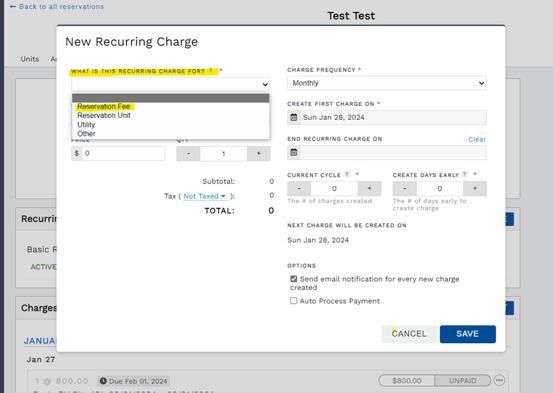
3. Write in a description of the charge.
The charge description determines what the title of the charge will be when posted, this is what the guest will see on invoices, their guest portal, etc.
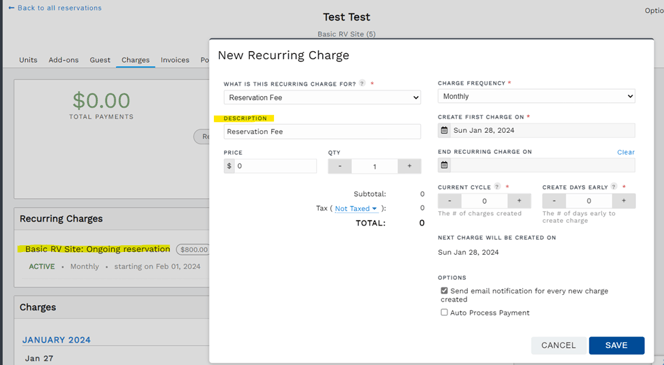
4. Set the recurring charge price, quantity, and taxes.
Enter in the price or amount you will be charging to the guest.
The quantity can be a useful setting if a guest has multiple sites booked and you need to charge them at the base price of $3.50 but at a quantity of 2 to cover two sites. In this example, we only need to bill $3.50 once so we will leave the quantity at 1.
Apply taxes. If taxes are needed, you can select the tax dropdown and check all applicable taxes for the charge.
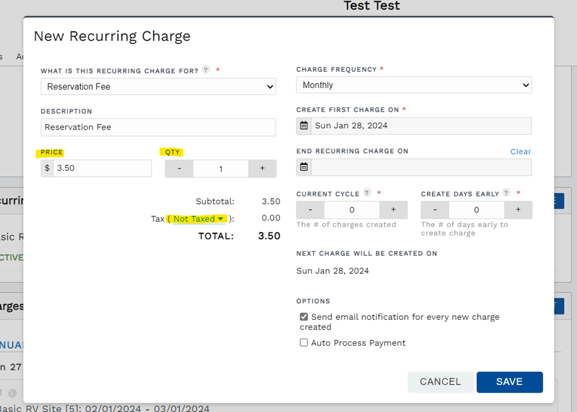
5. Set the Charge Frequency.
The charge frequency determines how often the charge will post. When creating a new recurring charge, the charge will be set to monthly by default, as this is most used. However, you may choose to post Annually, Weekly, or Daily instead.
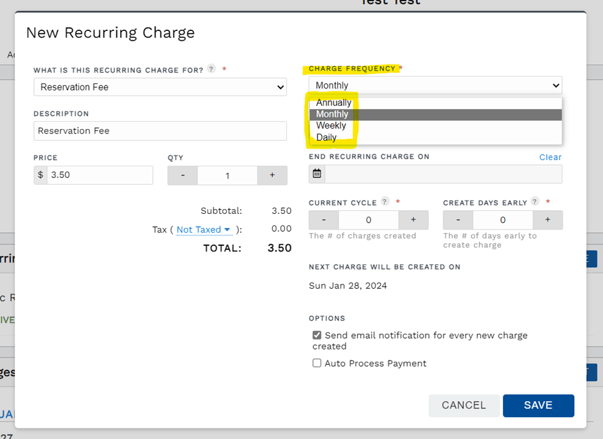
6. Set the “Create First Charge On” date.
When creating a new recurring charge, this date will determine when the first charge is posted, by default the system will select tomorrow’s date, adjust the date as needed.
IMPORTANT: Recurring charges will not auto post for dates that have already passed. If you need to backdate a recurring charge, you will set the date then post the first recurring charge manually, as shown in step 12.
7. Set “End Recurring Charge On” date, If applicable.
This is the day Firefly will no longer create the recurring charge. Leave the end date blank to post the charge indefinitely. When you enter a departure date for an ongoing reservation, this date is automatically set on the recurring charge as well so you do not need to enter an end date manually.
However, if you need to end a particular recurring charge ahead of the guest's check out date, you will set the end date here.
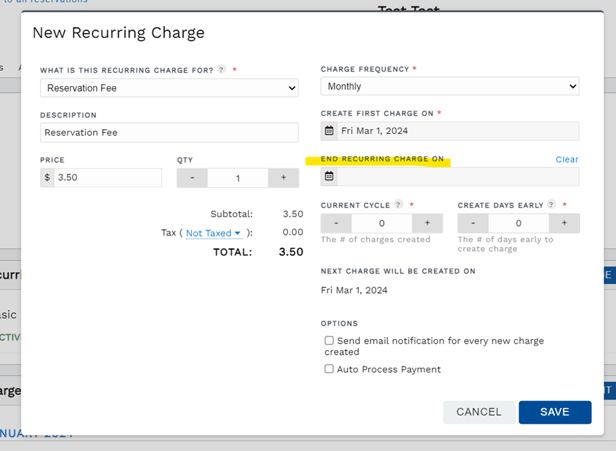
8. What is the Current Cycle?
The current cycle represents the number of charges that have been posted. In this example, there have been zero charges created, as this charge is being newly created, so the cycle is currently 0.
The current cycle drives the next charge date and must be set to 0 for the first charge to post on the Create First Charge date set above.
If the Create First Charge date is today or a past date, and the current cycle is set to 0, you must create the first charge manually. See step 12 for directions.
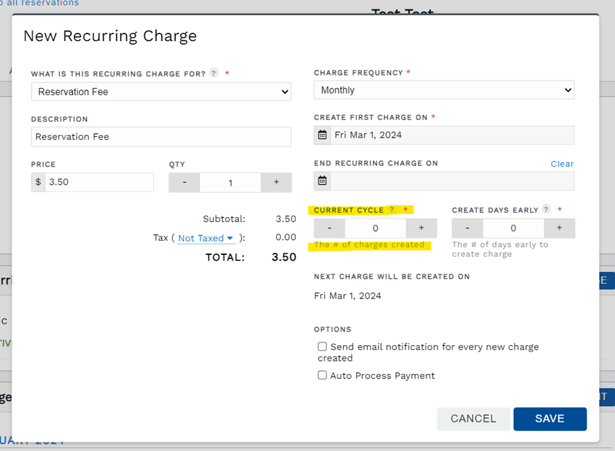
TIP: The current cycle can be used to manage posted charges.
You can decrease the current cycle to post a previous cycle's charge. In the example below, the cycle shows 1 recurring charge posted, which would have been for March 1st. If the recurring charge for March 1st was accidentally deleted or you are working retroactively, the current cycle can be reduced by one to reset the next charge date back to March 1st and then the March 1st recurring charge can be posted again manually. See step 12 below to "Create Next Charge" manually..
Alternatively, if you need to skip an upcoming recurring charge you can increase the current cycle to move the next charge forward one cycle. In the example below, if you increased the current cycle to 2 then the next recurring charge will post May 1st instead.
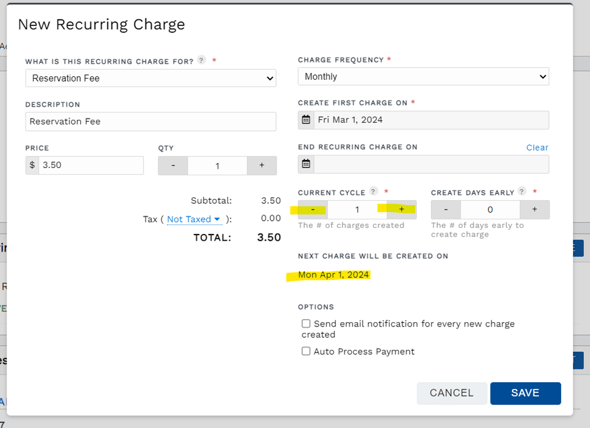
9. Set “Create Days Early”, if applicable.
If you would like the charge to be available before the due date, you can set the charge to create in advance. In the example below, we see a Create Days Early setup for 5 days which will create this March 1st charge on February 25th. This is especially useful for guests that prefer to pay their recurring charge before the due date or on a specific date every month.
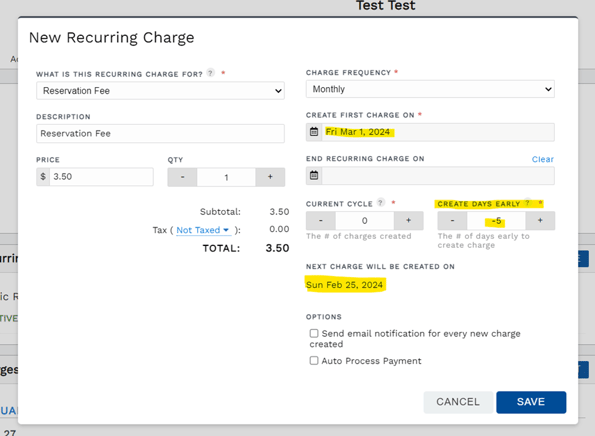
10. Email notification option.
When “Send email notification for every new charge created” is enabled, the guest will receive an email notification when each new charge is posted. This is especially useful if they do not have autopayments enabled, so the guest can be notified that they have a new charge and balance available.
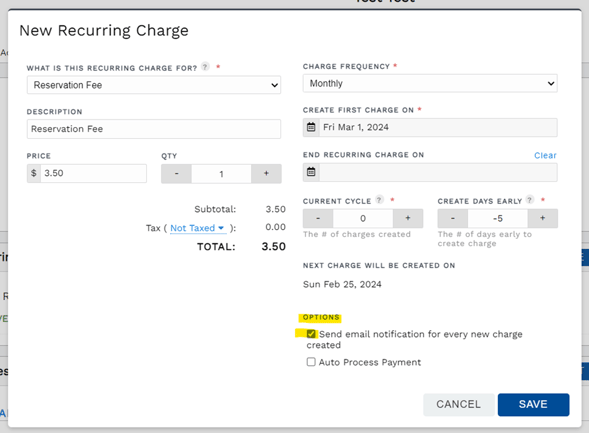
11. Automatic payment options.
You may set up a recurring charge to automatically create scheduled payments when a new recurring charge is posted. This feature is available when the guest has a payment method on file (credit card or ACH).
Once you select the Auto Process Payment option, you will see two additional option settings:
- Send email notification of upcoming payment and process payment in X days
- Process payment on specific day: X
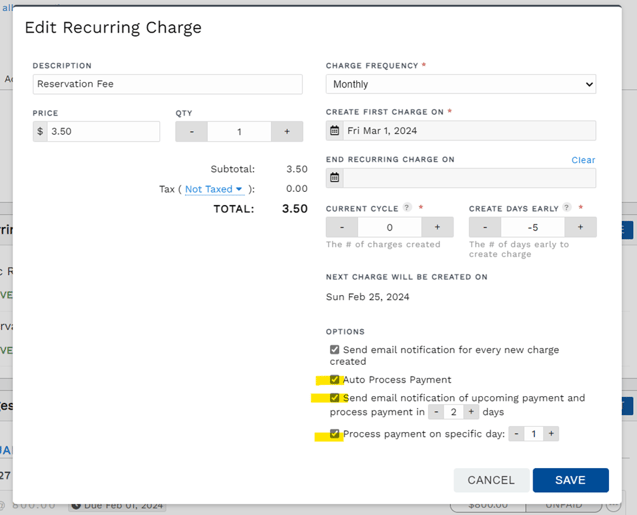
Select “Auto Process Payment” once you confirm the guest would like to automatically schedule a payment to the payment method on file when a new recurring charge is created. Unless set for a specific day, in the option below, autopayments process the day a recurring charge is created.
Select “Send email notification of upcoming payment…” if you would like to send the guest an email to remind them of their upcoming autopayment. In the example below, an email will be sent to the guest 2 days before the payment will process. This means once a recurring charge posts an automatic payment is scheduled but delayed for the number of days set in the email notification. Setting notification for 1 day will delay payment for 1 day, 3 days notification will delay payment for 3 days, and so on.
NOTE: If you wish to send an email notification of upcoming payment without delaying the payment, you must setup a charge to create early (step 9 above). For example, if the upcoming payment's desired email notification is 2 days then you must create the charge at least 2 days early.
Select “Process payment on a specific day” if the guest would like their payment to always be posted on a specific day of the month. In the example below, the guest’s payment will process on the 1st of the month even though the charge will be posted on the 25th. Leave this box unchecked if the recurring charge is a daily or weekly frequency. If this option remains unchecked,
CAUTION: The option to "Process payment on a specific day" will always be on or after the current month's recurring charge date. For example, if the recurring charge date is April 5th and you set the payment day for the 1st, the payment will process on May 1st. It will not process on April 1st as this is before April's recurring charge automations.
You can now SAVE THE CHARGE.🎉 The recurring charge's setup is complete.
Edit a Recurring Charge
You may edit the settings of an existing recurring charge at any time. On the recurring charge's setup, click the 3 dots then select Edit.

A pop-up opens with the recurring charge's setup. The settings to edit a recurring charge are the same as creating the recurring charge.
To make an edit, you simply adjust a setting as needed and click Save when all done.
For more information about a specific setting, see the Quick Links above to go to a specific section.
Manually “Create next charge”
If you start a charge on a previous date, sometimes called backdating the charge, you will need to create the first charge manually. This feature is also useful when a guest would like to pay a charge early, but the charge has not yet posted to the reservation's Charges tab.
To manually create a recurring charge's next charge:
- Go to the reservation's Charges tab and find the Recurring Charges section. It is just below the Summary box at the very top of the page.
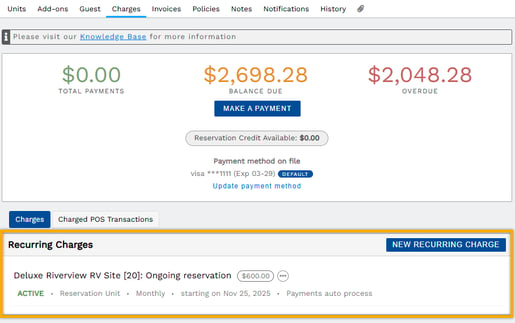
- Click the recurring charge's 3 dots then select Create next charge.
